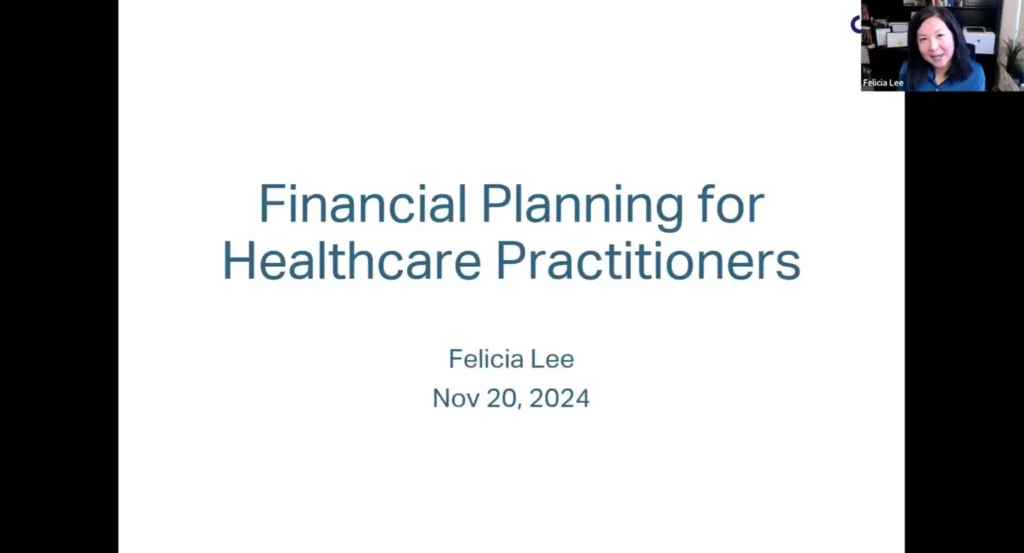Insights for
Financial Success

Partners In Practice: How To Successfully Share Healthcare Business Ownership
We recently wrapped up our first-ever webinar, and we are thrilled with how well it went! A huge thank you to accountant Dat Wong and lawyer Jacqueline Flett for co-hosting this session—we’re already looking forward to the next one.
In case you missed it, we’ll summarise what we covered, and provide a recording for you to watch in case you want to take some more detailed notes (highly recommended).
In this session, we covered different aspects of financial planning to help you ensure all your bases are covered with regard to shared business ownership or partnership arrangements. This webinar specifically covered topics that are relevant to healthcare business owners.

Structuring Your Business Through Accounting and Taxes—Dat Wong
To start off, CPA Dat Wong—who has over 20 years of accounting experience in the areas of public practice, mining, financial services and high-tech industries—walked through the differences between the 3 main types of business entities in Canada. For context, these 3 types of entities make up around 85% of all Canadian businesses:
- Sole proprietorships
- Partnerships
- Corporations
Sole Proprietorships:
Lots of businesses start out as sole proprietorships, as these are the quickest and easiest to set up. The advantages are that profits are paid directly to the owner, who has total control over the business and its assets. However, the owner is also fully liable for any debts taken out for the company, as the CRA doesn’t differentiate between the owner and their business in this type of setup.
When you are filing taxes as a sole proprietor, you will need to report your business when submitting your annual T1 personal return, using a T2125 business schedule.
Partnerships:
As the name suggests, partnerships involve 2 or more business owners running a company together. Similarly to sole proprietorships, the CRA does not see these owners as separate from their business, and partners are individually or collectively responsible for any company debt.
Control of the company is determined by a partnership agreement (more on this down below), as are profit sharing and asset control. Filing taxes is similar to the sole proprietorship model, with the caveat that you must also declare what share of the company you are responsible for.
Corporations:
In contrast to sole proprietorships and partnerships, corporations are considered separate entities from their owners and shareholders. This means that a separate T2 tax form is required, filed separately from shareholders’ personal tax returns. In this structure, profits earned either stay within the corporation, or are redistributed to shareholders. Debts are repaid by the corporation—unless shareholders have personally guaranteed a loan, in which case they would be responsible. The company’s assets are also owned and controlled by the corporation, not its shareholders.
In the webinar, Dat also covered important accounting considerations for these three types of entities. Watch the full session here.

Partnership and Shareholders Agreements In Healthcare Practices—Jacqueline Flett
Lawyer Jacqueline Flett has a lot of experience working with small-to-medium sized businesses, and in this session, she covered the all-important shareholder agreement.
This contract governs the relationship between owners and the business. It defines rights, responsibilities and obligations, and offers protection beyond basic corporate law (which is often insufficient on its own).
These agreements are especially important in the healthcare industry, due to stringent regulatory requirements. By pre-planning and creating a partnership agreement before any issues arise, you can determine a process to solve any potential disagreements.
Jacqueline shared the top 5 reasons why you need a shareholder agreement:
- Preventing disputes among shareholders.
- Determining succession planning and an exit strategy.
- Creating an agreed method for share valuation.
- Laying out financial obligations and contributions.
- Protecting the reputation and operations of the practice.
Watch Jacqueline’s presentation here for a more detailed explanation of these 5 reasons and their importance.

Financial Planning For Healthcare Practitioners—Felicia Lee
In this portion of the webinar, led by Felicia Lee, she outlined the intricacies of financial planning and how we approach this process with our clients in 2 simple steps: 1) Personal planning and 2) Business planning.
Because financial planning can involve so many different factors (practice growth, tax and accounting, legal, investments, insurance, etc), a lot of different types of professional support can be required—which is often tricky to keep track of.
That’s why we step in to help you manage all the different aspects of your financial plan, so that you can focus on reaching your goals while we make sure you’re set up for long-term success.
To learn more, watch Felicia Lee’s session here.
If you want to watch the full webinar, you can access the recording here.
Questions about navigating shared ownership from a financial perspective, or any other financial planning concerns? Feel free to reach out to us.

